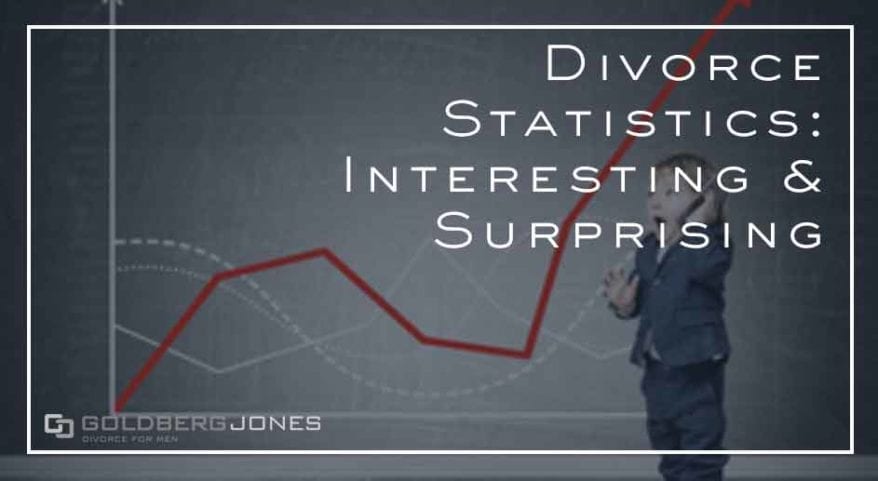Looking at divorce statistics often gets overwhelming. It’s harrowing to hear that oft-repeated statement that 50% of marriages end in divorce. (FYI: The 50% figure is not accurate and has never reached that level.)
Sometimes it’s tough to interpret the raw numbers and determine what they really mean. With that in mind, let’s take a look at some interesting, useful, or just downright surprising divorce statistics and provide some additional context.
By the Numbers
- The median ages for first marriages in the United States are 26.9 years old for men and 25.3 years old for women.
- On the other end, the average age for couples going through their first divorce is approximately 30 years old—30.5 for men, 29 for women.
- The average length of a first marriage that ends in divorce is roughly eight years—7.8 years for men, 7.9 for women.
- Moving into second marriages that end in divorce, the timeline shortens somewhat. In these cases, the median length for men is 7.3 years, while for women it drops to 6.8 years.
- If a person does ultimately remarry, the average time between their divorce and the next wedding is around three years—3.3 years for men, 3.1 years for women.
- 2021, the most recent data available, saw 689,308 divorces and annulments in the United States. This represents a drop from 877,000 in 2011. In fact, the number of divorces in America has declined almost every year this millennium.
- This number breaks down to almost 1889 divorces per day. Which averages out to roughly 79 divorces per hour and just over 1.3 divorces per minute.
Related Reading: Millenials, Boomers, And Gen X-ers Oh My: Breaking Down Divorce Rates By Generation
More Marriages = More Divorces
It seems logical to think that after one divorce, people are less likely to divorce again. You learn some things through your experience and emerge wiser, with a better sense of what you want and need. Right?
That certainly happens in some cases. People become more cautious and make sure a relationship is sturdy and stable before taking that next step. But that’s not how it happens in every case. Looking at the divorce statistics illustrates this point.
In reality, with each subsequent marriage, the chances of divorce greatly increase. The numbers break down like this:
- 41% of first marriages end in divorce.
- 60% of second marriages end in divorce.
- 73% of third marriages end in divorce.
While these numbers appear staggering at first glance, it helps to remember that as a person goes along, the sample size shrinks significantly. There are substantially fewer third marriages than second, and substantially fewer second than first marriages.
However, after all of this, if you still marry a fourth time, you may just be a glutton for punishment.
Related Reading: What are Grounds for Divorce in Oregon?
How Common Are Second Marriages?
Divorce is so commonplace that most people barely bat an eye when finding out someone was married. Most of us have friends, family members, or are ourselves divorced.
In 2004, a U.S. Census Bureau survey found that in 36% of weddings, at least one spouse was remarrying. That means, in more than one-third of marriages, one party had previously been married.
This doesn’t mean, however, that every marriage ends in divorce or that everyone marries multiple times.
In fact, like the divorce rate, the rate of remarriage has also declined steadily over the years. Research shows that between 1990 and 2019, the remarriage rate dropped nearly 50%.
Men are statistically more likely to remarry, with a 35.1% remarriage rate, than women, who remarry at a 19.4% rate.
Related Reading: Has The Divorce Rate Ever Been 50%? Nope.
Declining Marriage Rates
The overall marriage rate has declined steadily over the last few decades. Young people between the ages of 20-34 opting not to marry, or pushing it off until later in life, is a significant contributing factor.
Since 2000, the percentage of this age group who haven’t married has spiked in every state. According to one 2016 report, 81% of this demographic in Washington DC remains unmarried.
This number may be exaggerated in city centers where young people relocate to work, but it reflects a broader trend. In many states, the number currently hovers around 70%, whereas at the turn of the 21st century, the highest was 57%.
Recent numbers are themselves indicative of a larger evolution. As of the 2020 U.S. Census, 46.9% of the population, more than 92 million Americans, were part of a married couple. This marks a decline from 2000, where that figure was approximately 55%, which continues a trend. For context, in 1990, that number was in the 60% range, and in 1970, it was above 70%
Related Reading: 10 Truly Scary Divorce Facts
What Do These Divorce Statistics Mean?
In the end, what do all of these divorce statistics mean? They show current trends and illustrate how ideas on marriage and divorce evolve over time. They provide a removed, big-picture glimpse at the state of marriage and divorce.
What these divorce statistics don’t offer is a look at individual situations and specific circumstances. It’s easy to glance at these figures out of context and think everything is doomed. But these numbers are just that, numbers.
Divorce statistics that lean one way or another don’t mean that’s how every marriage plays out. Sometimes second and even third marriages stick and are wonderful. The people involved and the work they put in determine the success or failure of a marriage, not the numbers.
Related Reading: Breaking Down Rates Divorce By Generation

Comments 1
I been married to my wife for 31 years now and she is my first wife how I love with my hole heart so first marriage can and do last